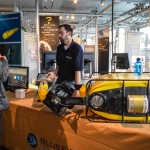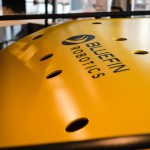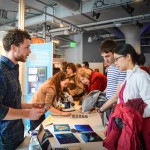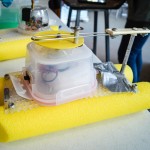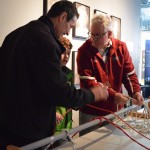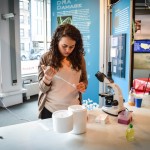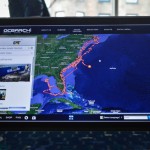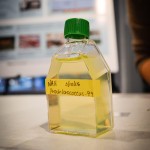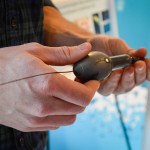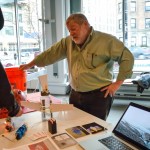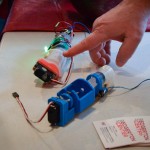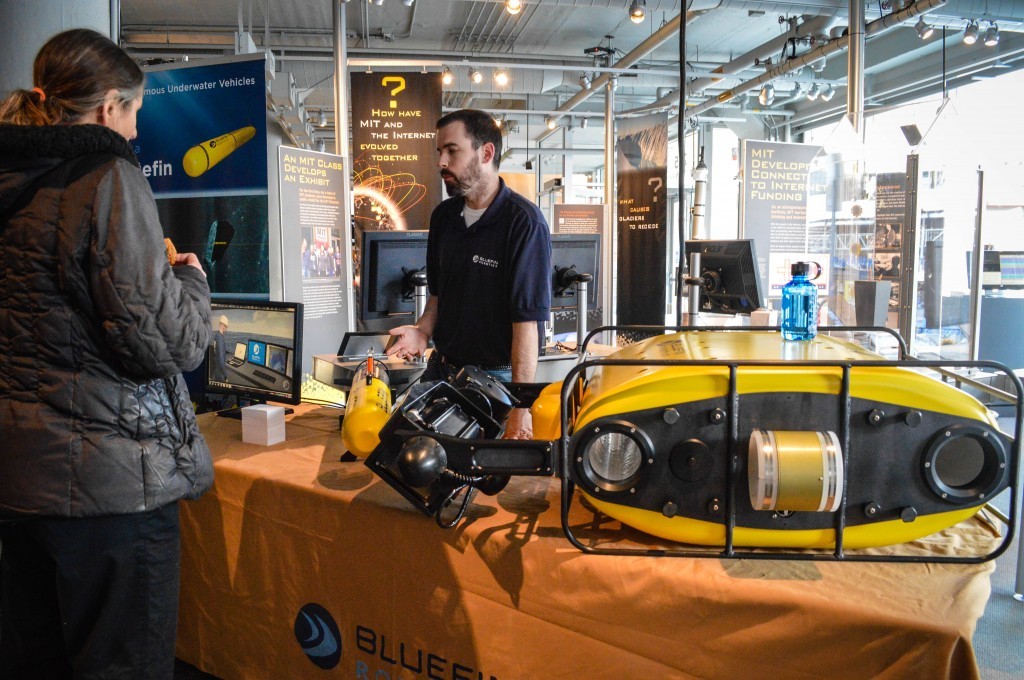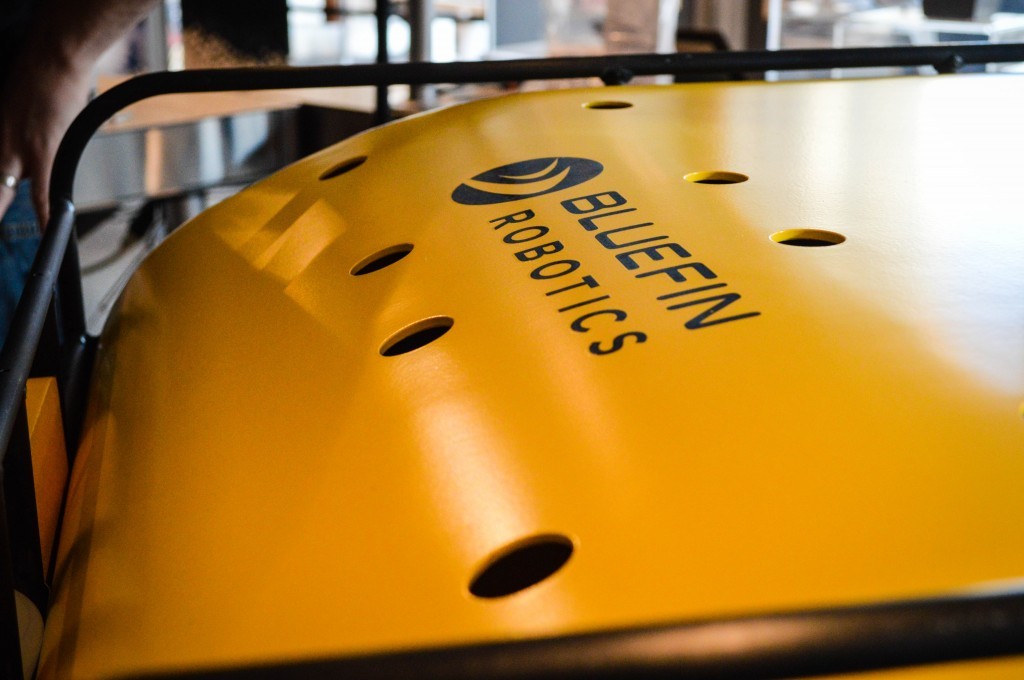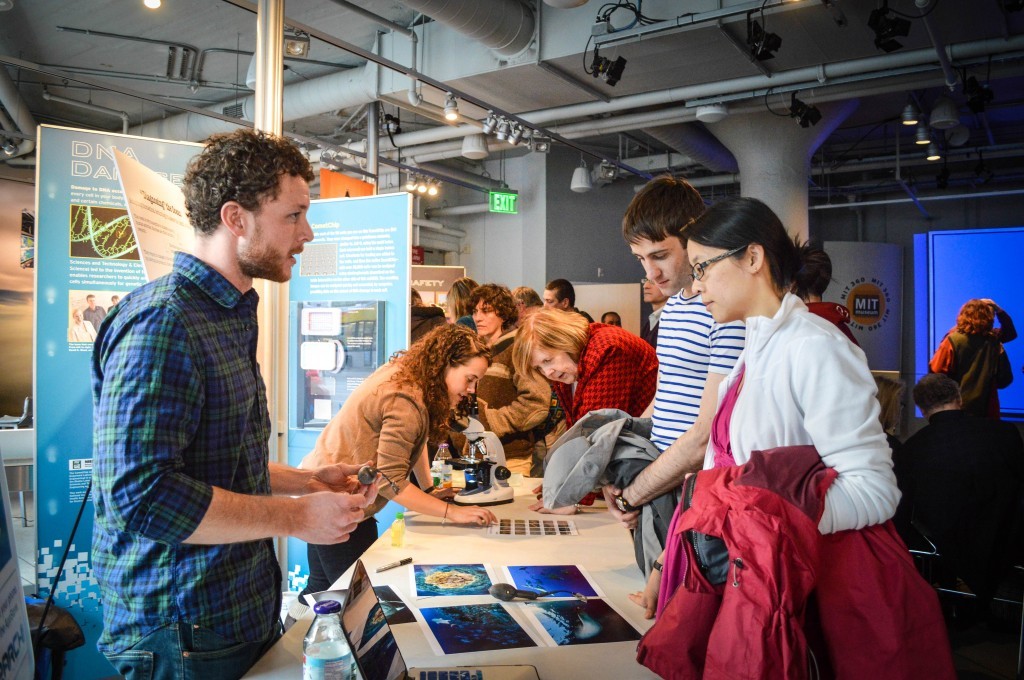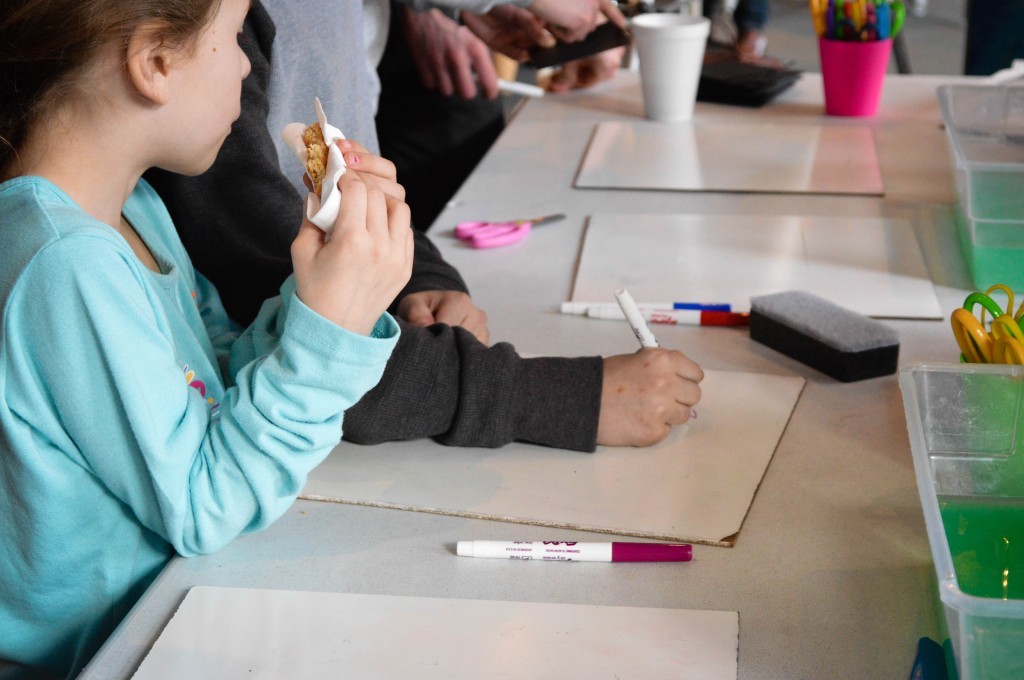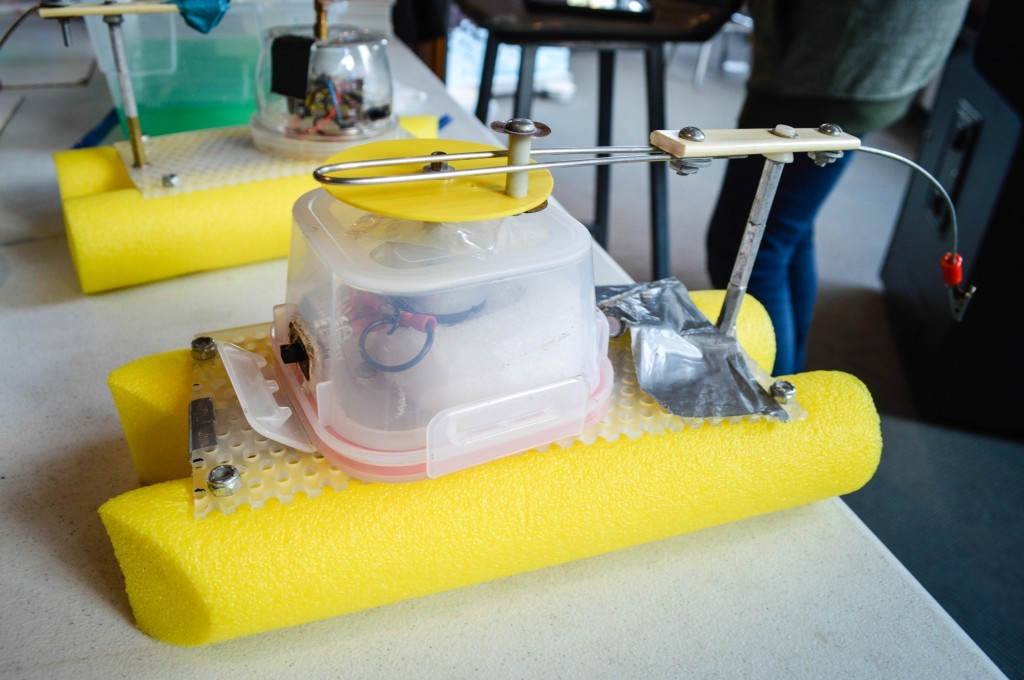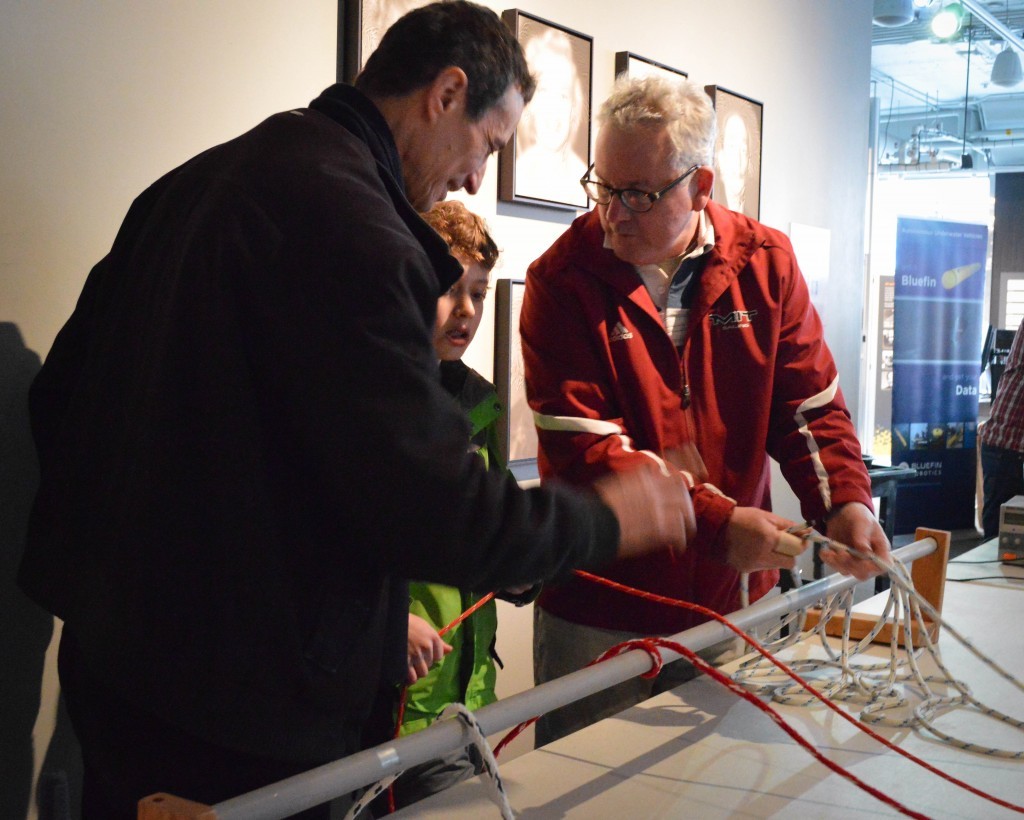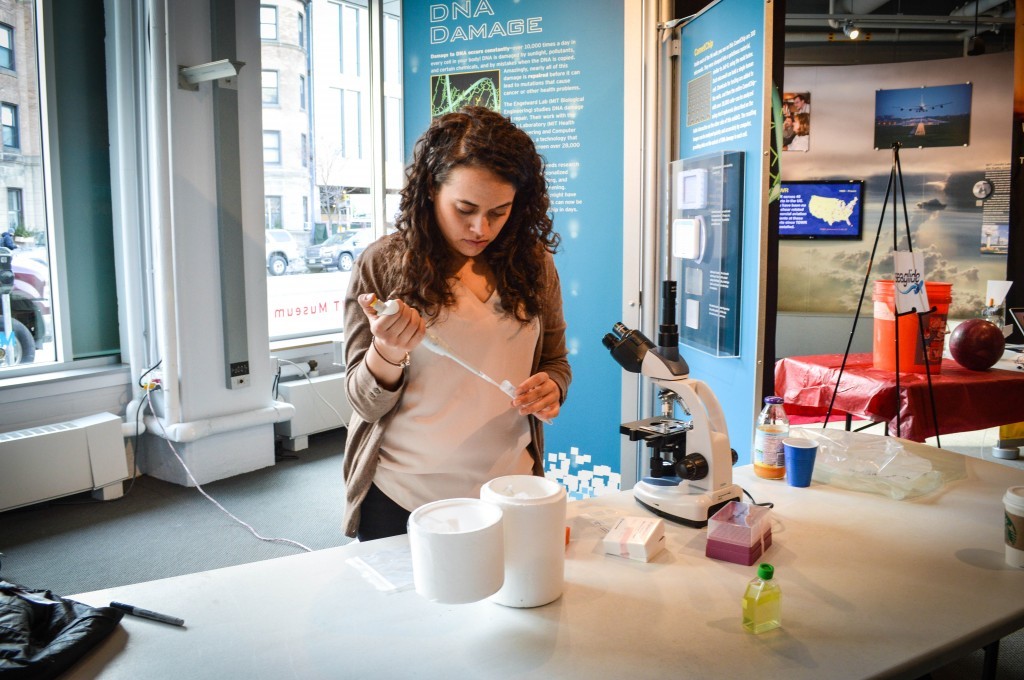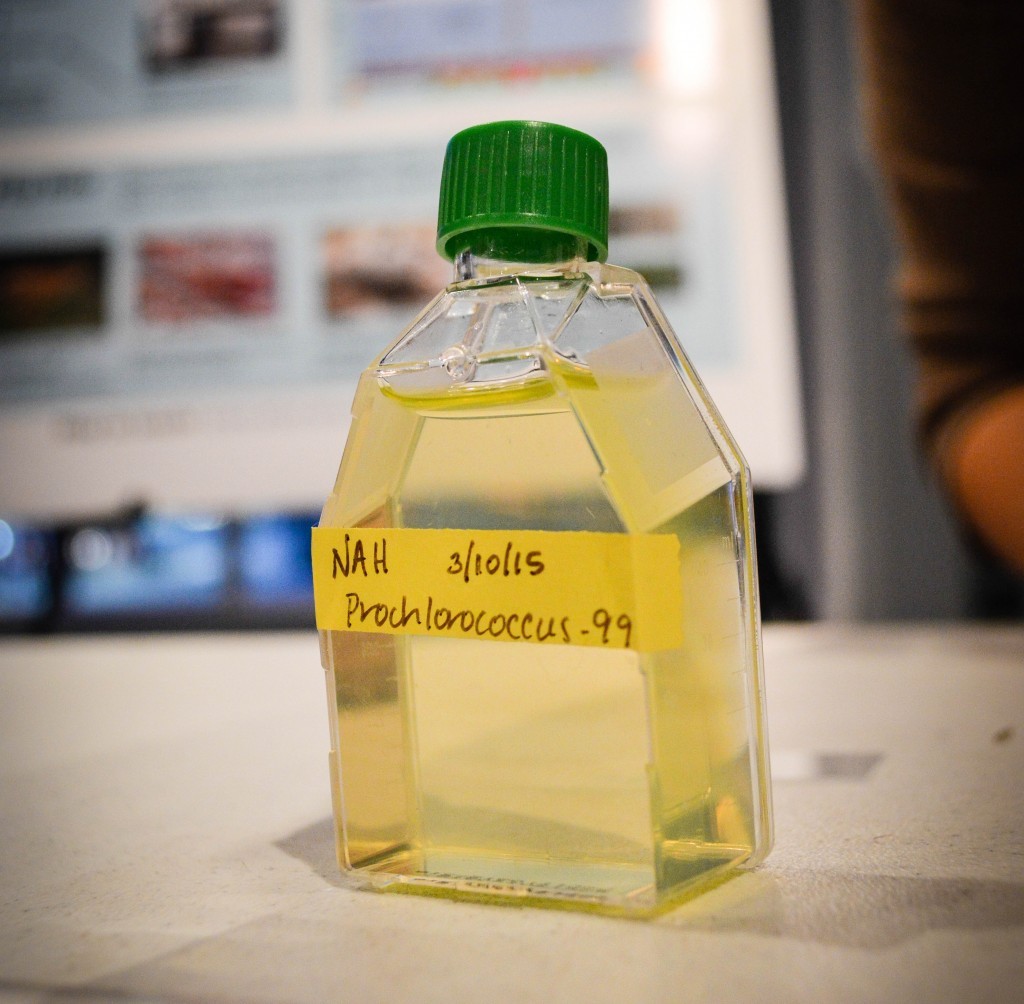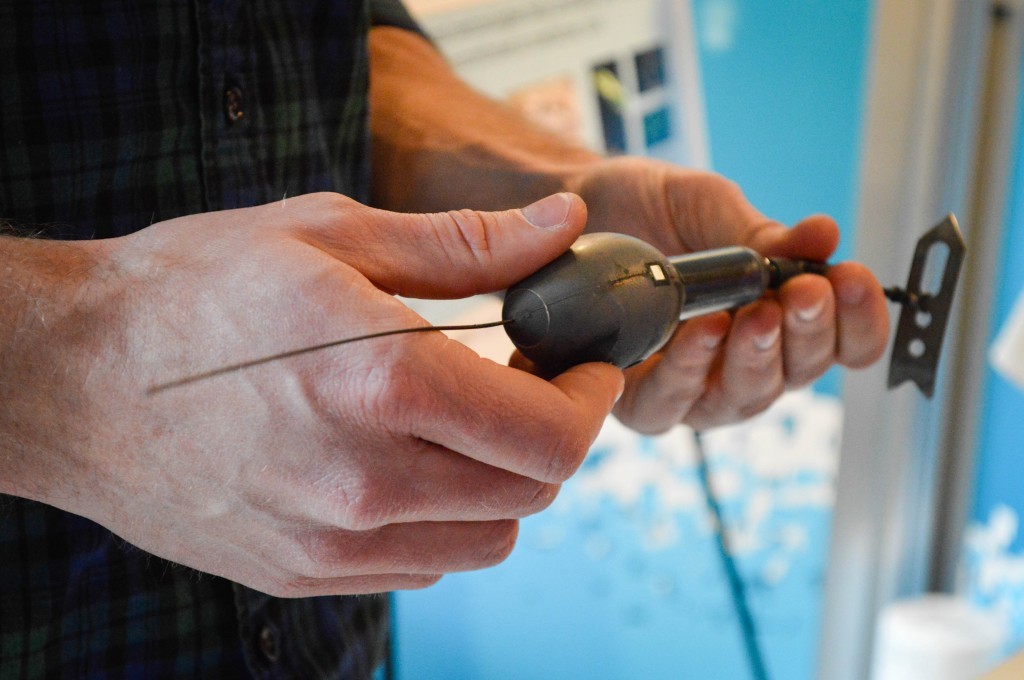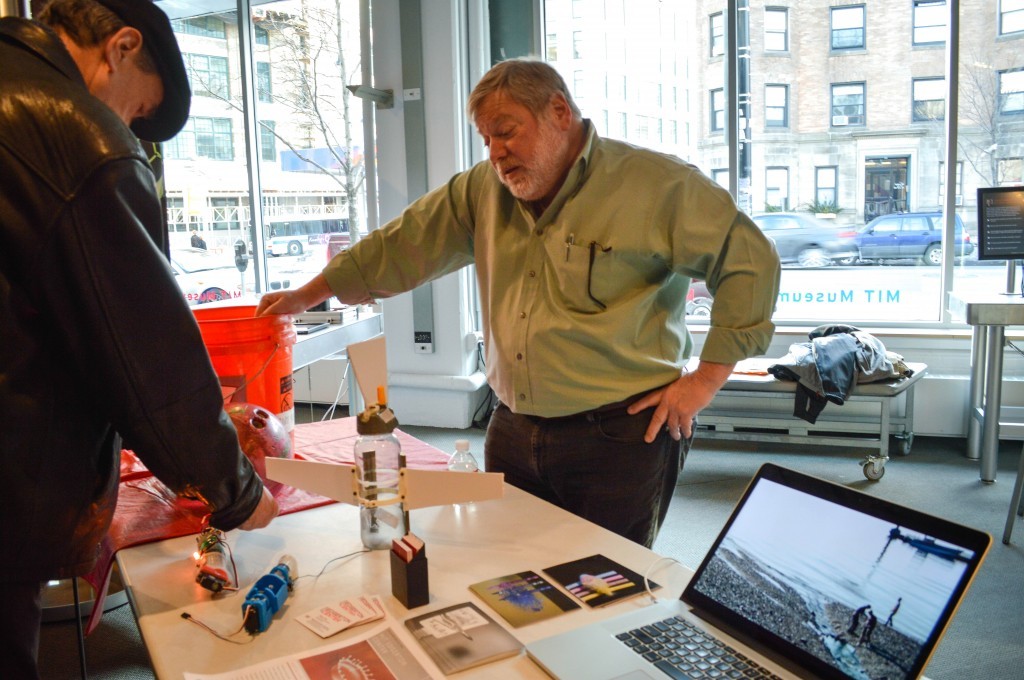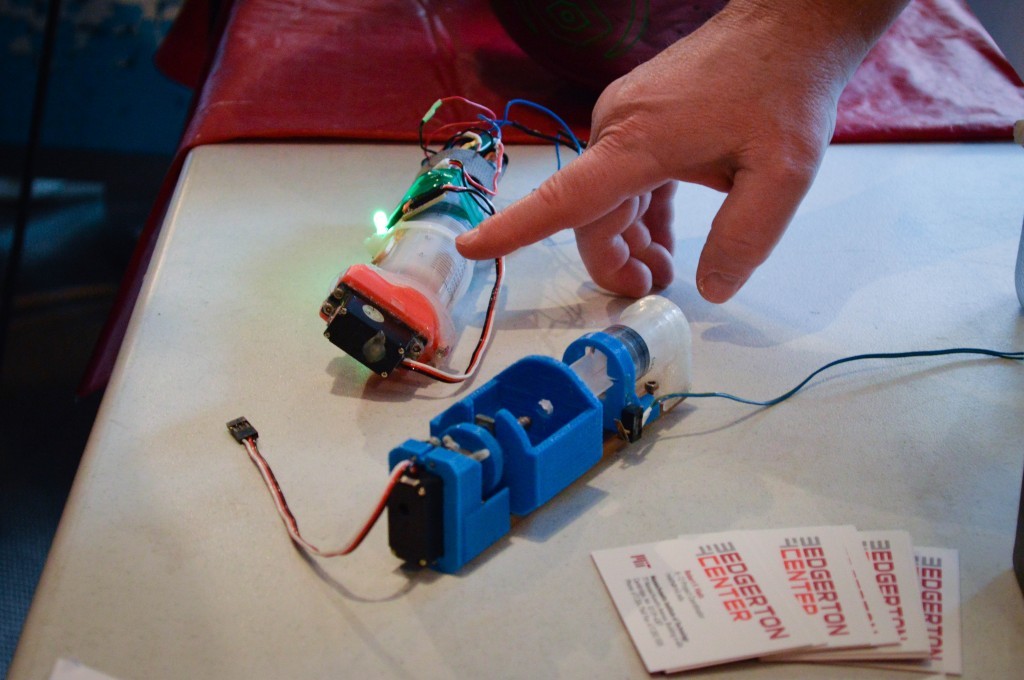Featured Stories | March 30, 2015
MIT Nautical Night Highlights 2015
By Cassie Martin
On the second Friday of each month, MIT Museum hosts performances, demonstrations, and short talks based on a theme for the MIT community and the public. Past programs have focused on subjects such as food, music made by glass-blown instruments, and innovative engineering, to name a few. More than 150 people gathered for March’s installment—the third annual Nautical Night—which featured talks and demonstrations by MIT faculty and students on topics including bio-inspired robotics, ocean health, sharks, and more!
Oceans at MIT Highlights
MIT Maritime History

Bio-Inspired Sensors
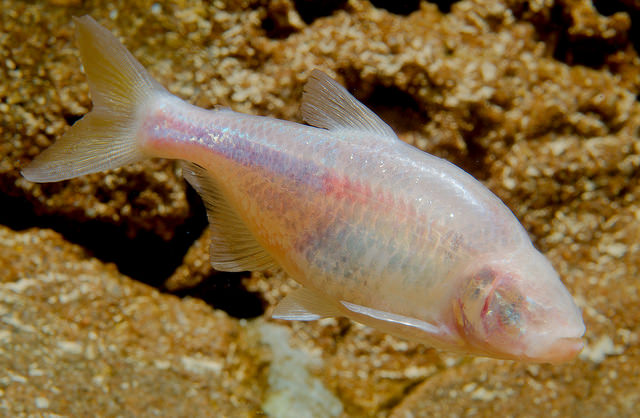
Herreshoff may have laid the foundation for modern sea-fairing vehicles, but MIT researchers are refining their navigational abilities using bio-inspired sensors. Jeff Dusek, a graduate student under Professor of Mechanical and Ocean Engineering Michael Triantafyllou in the Department of Mechanical Engineering (MechE), discussed the technology his lab developed based on two marine organisms. First, a pressure sensor based on a sensory organ found in Mexican Cave Fish. These blind creatures use lateral lines—bundles of microscopic hairs similar to cilia found in humans’ inner ear—to maneuver around objects, track prey, and sense vortices enabling the fish to save energy while swimming. The resulting sensor array made from silicon and other polymers, is lightweight, flexible, energy-efficient, and sensitive enough to measure pressures and vortices in rough, turbid water. Another water flow sensor designed in the lab is based on seal whiskers. The whiskers’ unique shape allow the carnivorous marine mammal to distinguish fish swimming nearby from boats or other disturbances in the water. Added to ship hulls, this sensor not only enhances vortex measurements, for instance, but it also reduces noise and improves marine vehicle dynamics. “[The sensors] give us extra perception of what’s going on with the vehicle,” said Dusek. “We’re adding to ships’ capabilities based off what fish do.” Read more about this bio-inspired sensor work at MIT News.
Coral Microbiome
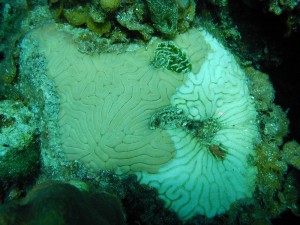
Microbes dominate the ocean, representing more than 90 percent of its biomass and mediating important processes such as biogeochemical cycling and ecosystem food webs. Microbes also play a key role in ocean health, through their interactions with other organisms such as corals. Janelle Thompson, the Doherty Assistant Professor in Ocean Utilization in the MIT Parsons Lab is using genetics to determine how microbes influence coral health and disease, specifically white plague. The cause of the disease—characterized by the deterioration of living coral tissue, exposing corals’ limestone skeleton to colonization by algae and other invertebrates—remains unknown, but the first step in identifying it is narrowing down potential pathogens. Thompson sequenced DNA collected from healthy and diseased coral off the coast of Brazil and found more than 7,000 species of microbes, three of which are known pathogens and found in higher abundance of sick corals. Thompson’s take home message for the audience: The coral microbiome is constantly changing, and researchers should consider all parts of the organism—microbes included—in their quest to diagnose and save it. Learn more about Thompson’s research here.
Extreme Weather

Sai Ravela, a principle research scientist in the Department of Earth, Atmospheric, and Planetary Sciences, discussed the challenges of predicting and modeling extreme weather including hurricanes and cyclones. Because of the complex nature of these events and the vast size of their models, what would otherwise be small errors can become exponentially amplified and distorted. Ravela uses a combination of machine learning algorithms, artificial intelligence, and statistics to quantify these errors (or uncertainties), and works to find new ways to fit models to real-world observations. “Despite the fact we are fairly confident climate is changing and are aware of anthropogenic contributions, there remains a lot of uncertainty in quantifying estimates of impacts of these changes,” he said. “Decisions made by local government, policymakers, activists, or people interested in investing in property, should be informed by this uncertainty.”
Robotics
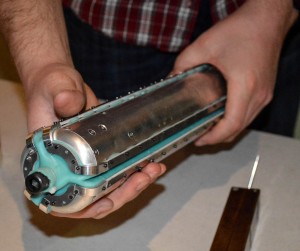
In addition to the various talks, graduate students from MIT and Woods Hole Oceanographic Institution (WHOI) demonstrated their research projects. Three unique aquatic robots, designed by MechE students, drew a lot of attention from the crowd. Jacob Izraelevitz, a lab mate of Dusek’s, showed off his dual air and water robot called an aquathopter. Inspired by sea birds such as murres and puffins, it can change its wing trajectory to better control thrust in both mediums. This research could eventually lead to super-maneuverability of ocean vehicles, said Izraelevitz.
Dan Dorsch, a graduate student under Assistant Professor Amos Winter in the MIT GEAR Lab, demonstrated the lab’s roboclam. Inspired by Atlantic razor clams, this robot can burrow into soil without expending much energy by liquefying the soil around its shell. Bluefin Robotics—a manufacturer of underwater autonomous vehicles for scientific research, sea floor and mine surveying—use roboclams as anchors for their vehicles and to bury underwater cables.
The last robot on display was a prototype of a 3D printed underwater microdrone. Graduate student Sampriti Bhattacharyya and her adviser Harry Asada, the Ford Professor of Engineering, designed the football-sized drone to look for cracks in nuclear reactor water tanks using ultrasound and sonar, but the technology could have other applications including collecting data on ocean environments or scanning ships for contraband and smuggled goods. Read more about microdrones and roboclams at MIT News.
Ocean Life
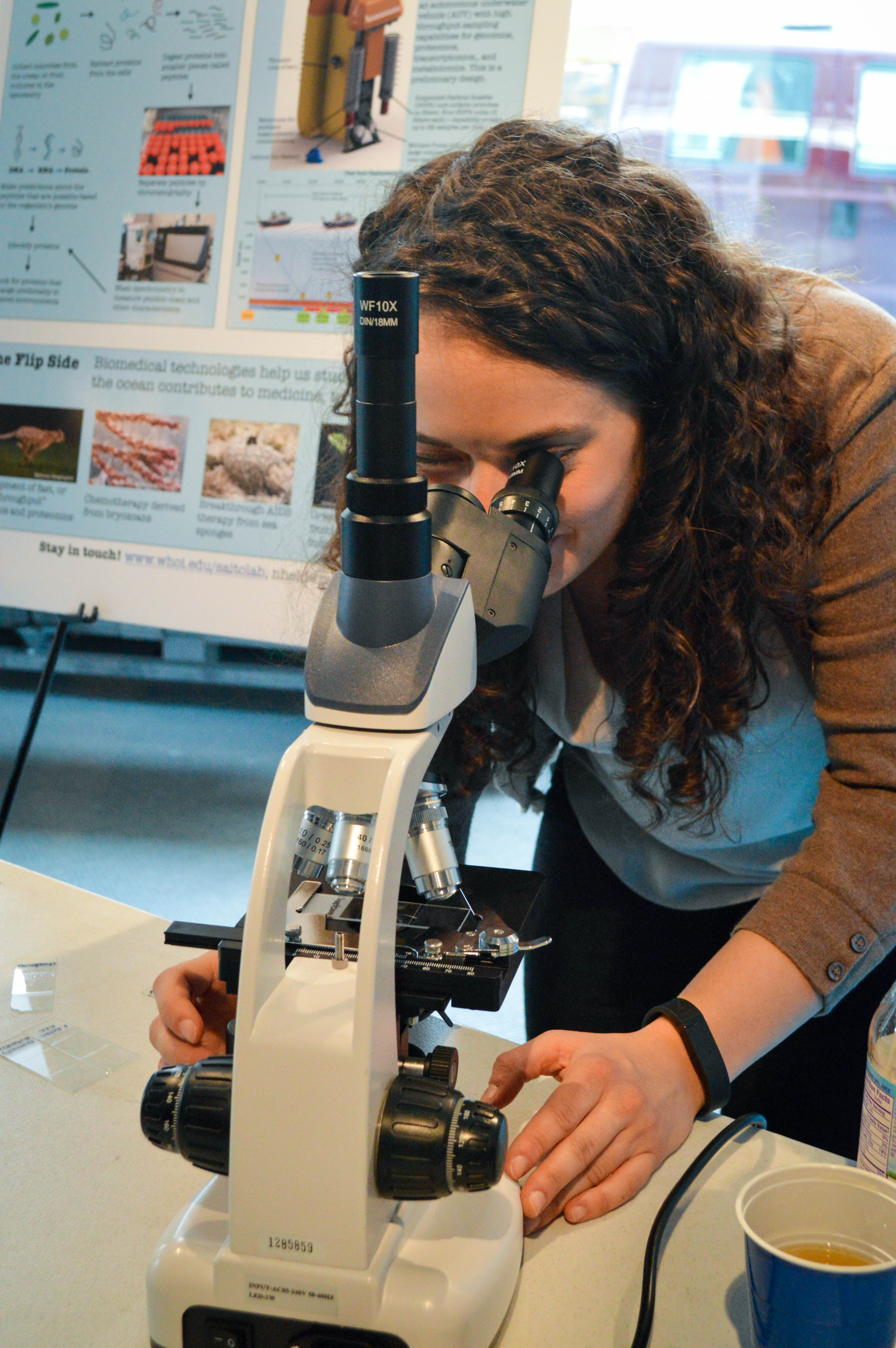
The world’s oceans are teeming with life, ranging from giants like blue whales to microscopic bacteria and plankton. Two graduate students in the MIT-WHOI Joint Program, Camrin Braun and Noelle Held, dazzled the crowd with technology that monitor ocean life big and small. Braun uses satellite tags to track sharks and other pelagic fish including rays, big-eyed tuna, and swordfish in near real-time. These fish have implications not only for marine ecosystems, but also for the world economy. Because they move enormous distances, it’s hard to learn about their life cycles and behaviors—especially those of sharks. Data from the tags, which also record ocean features such as depth, temperature, and light, can tell researchers about how and why sharks move in the ocean, as well as inform policymakers on conservation strategies. “If we don’t know where they go, then we don’t know who needs to be at the table. In the end, that’s why we do what we do—to keep them around,” said Braun. “The field is limited by technology, but it’s rapidly evolving, so we can ask and answer more questions.”
While Braun showed visitors tags, satellite maps, and his photography of various shark species, Held was busy looking through a microscope for the world’s most prolific photosynthetic organism—Prochlorococcus. Held is interested in how microbes interact with the environment over time and using that information to diagnose ocean health. This isn’t a new concept, but Held’s lab is developing new technology that would make ocean sampling faster and more efficient. Clio, an autonomous vehicle and sampling platform, automatically filters large samples of water at different depths—dictated by researchers at the surface. Clio and similar technologies could boost global surveys of marine DNA, RNA, proteins, metabolites, and metals. Currently in the conceptual design phase, a prototype will likely be released next summer.
Ocean Outreach
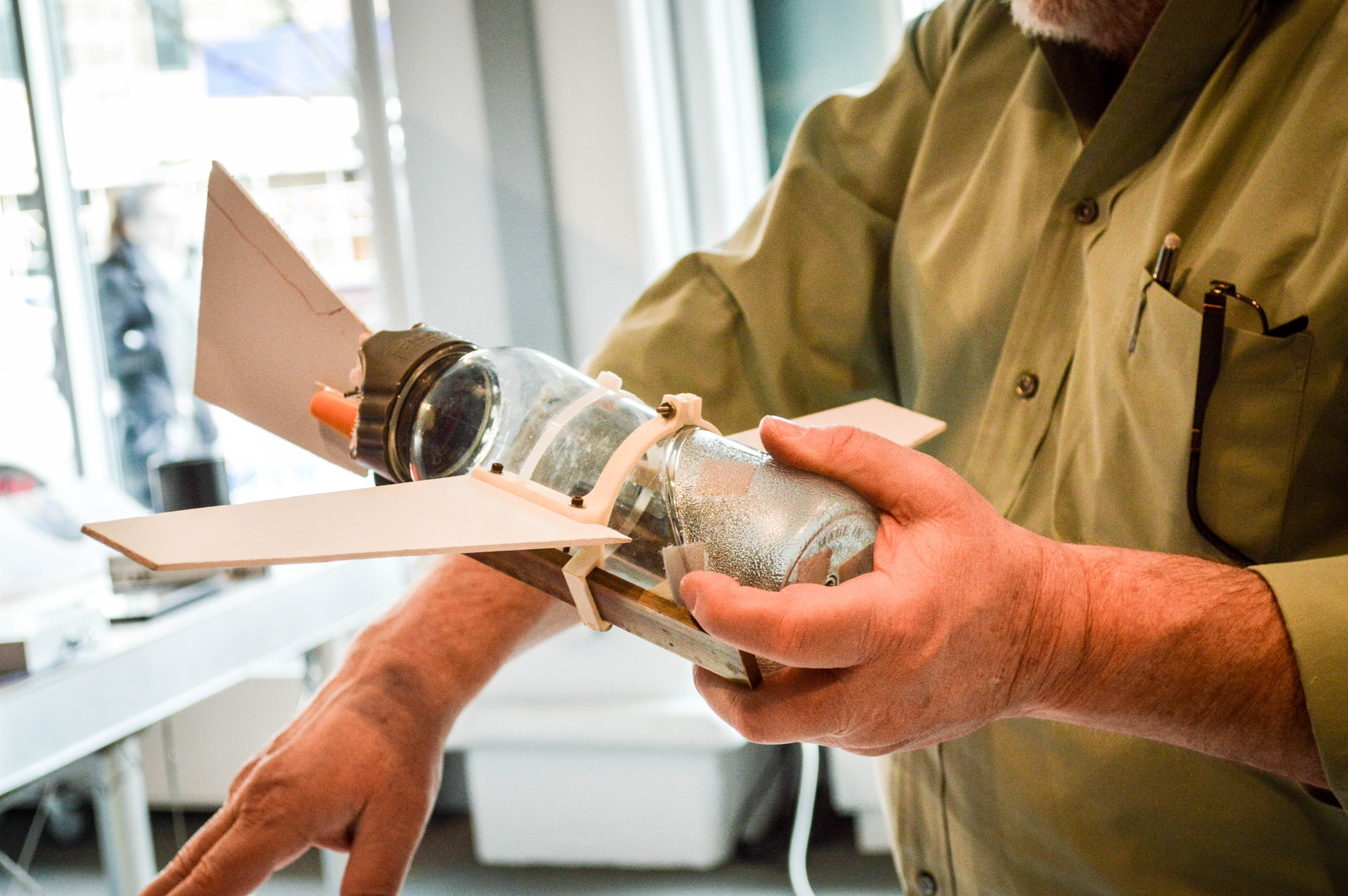
People young and old are fascinated by the world’s least explored and most vital frontier—the ocean. Robert Vieth, Director of the Edgerton Center’s SeaGlide program, is dedicated to teaching high school students around the country about marine engineering and research. SeaGlides are underwater autonomous gliders made from plastic water bottles, 3D printed wings and tails, and syringe motors with attached microprocessors. During a two-week summer workshop held at MIT, Vieth and students work side-by-side with MIT instructors and engineers to build swarms of gliders. Vieth is currently developing a sensor platform for SeaGlides out of SD cards, motion sensors, and compasses that will record temperature, pressure, salinity and turbidity data. He hopes that SeaGlide will eventually become a large-scale citizen science data collection and analysis network.
*****
MIT Nautical Night provided a small glimpse into the incredible ocean-related research occurring at MIT and WHOI. Oceans@MIT is dedicated to reporting on MIT’s efforts to understand, protect, and harness the world’s oceans—so stay tuned, and check out more Second Friday programs here.



